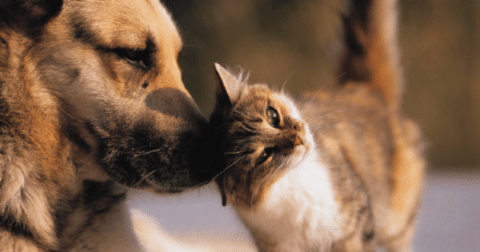News
Could Genetically Engineered Fungus Help Replace Animal Protein?
Breakthroughs•5 min read
Explainer
What animal cooperation can teach us about our similarities and differences as species.


Words by Seth Millstein
Many people think of the animal kingdom as a hypercompetitive world, where creatures only look out for their families and stop at nothing to get the leg up on each other. It’s every species for itself — or is it? In truth, the animal world isn’t quite as cutthroat as nature documentaries might have you believe, especially given the fact that humans, and the way we eat, are often a much greater threat to animals than other predators. There are plenty of examples of different species of animals working together in nature, and helping one another out to both creatures’ benefit.
Symbiosis refers to a close, long-term biological relationship between two species living in close proximity. There are three types of symbiotic relationships: commensalistic, parasitic and mutualistic. Commensalism is when one species benefits from the relationship while the other derives neither benefit nor harm. Parasitic relationships benefit one species while actively harming the other.
Mutualism is the third type of symbiotic relationship, and it’s the one we’ll be discussing here. In mutualistic relationships, both species benefit by interacting with the other — a net-win for everybody involved.
There are plenty of examples of mutualism between plants and animals. For instance, wooly bats like to relax in the mouths of carnivorous pitcher plants; the bat gets a safe place to stay, and the plant gets the nutrients from the bat’s guano or excrement.
Where things get even more interesting, though, is when two different species of animal cooperate with one another. While not all of these relationships are well-understood, all are fascinating counterexamples to the ruthless, “dog-eat-dog” vision of nature that’s often propagated in pop culture. Let’s have a look at a few of them.
The coral grouper is a reef fish that effectively “recruits” moray eels, and sometimes other aquatic species, to help them hunt.
How does the grouper communicate with an entirely different species? By wiggling. If a fish that a coral grouper is chasing manages to hide in a rock or crevice, and a moray eel is nearby, the grouper will swim to the eel and shimmy in front of them enthusiastically. This is the signal for the eel to follow the grouper.
When the grouper arrives at the prey’s hiding space, they tilt themselves 90 degrees vertically and wiggle their head at the location of the prey. This is the signal for the eel, who is adept at navigating small crevices, to get in there and flush out the prey. If the eel doesn’t respond to the initial sign, the grouper will swim back to them and shimmy again, or in some cases, try to physically push them toward the prey.
It may sound odd, but you can’t argue with the results: research has found that both species have higher success rates when hunting collaboratively than on their own. Later studies found that a similar species, the coral trout, uses the same strategies and signals to recruit octopuses as hunting partners.
Not long ago, a video surfaced online appearing to show a badger and a coyote working together — or at least traveling together — at night.
In the video, a coyote waits by a large drainage pipe, looking at something off-camera. She then begins jumping up and down excitedly, and moments later, a badger walks into frame. With the badger in tow, the coyote resumes her trek through the drainage pipe, looking back periodically to make sure the badger is still following.
It’s a cute video — but does it actually show a badger and coyote joining forces as hunting buddies?
Yes, it does. Coyotes and badgers both hunt ground squirrels and prairie dogs, but in different ways: badgers dig into the rodents’ underground burrows and drag them out, while coyotes prefer to wait until a ground squirrel emerges from a burrow and then pounce.
By hunting as a team, they have both bases covered. If the ground squirrel tries to escape by hiding in a burrow, the badger digs them up; if they try to escape by fleeing the burrow, the coyote is sitting at the exit, waiting to pounce. Research has shown that both species have a higher success rate in their hunts when working together in this way.
Many spiders dine on small amphibians, and tarantulas are no exception. But there’s one type of amphibian they won’t eat: the dotted humming frog. When the two species cross paths, the tarantula doesn’t just let the frog live; she protects him, and lets him move in with her.
In theory, these tiny frogs should be the first thing the spiders reach for when they want a tasty snack. And yet the two species are frequently seen coexisting peacefully together, both aboveground and in the underground burrows in which tarantulas lay their eggs. This gives the frog much-needed shelter from predators, but the protection doesn’t stop there. Humming frogs also hide underneath tarantulas when they’re aboveground, essentially using them as a physical shield against predators.
The benefit to the frog is obvious, but what’s in it for the tarantula? Security — not for the tarantula, but for her eggs. Ants eat tarantula eggs, and dotted humming frogs eat ants. By allowing the frog to hang out in her burrow, the tarantula can leave her nest to go hunting, knowing that her eggs will be safe. The frog, as an added bonus, gets to feast on any prey remains that the tarantula doesn’t finish.
It’s theorized that this relationship began because the toxins on frog’s skin are unpalatable to the tarantula. Younger tarantulas have been seen pouncing on humming frogs, inspecting their skin with their mouths, and then letting them go.
Pistol shrimp are prolific diggers, constantly creating and maintaining burrows on the ocean floor. They live in these burrows, which protect them from predators, and frequently move around to new ones. However, their eyesight is practically non-existent, making them extremely vulnerable to predators while they’re removing gravel during the burrowing process.
Thankfully, they’ve got an ally: gobies. These small fish have excellent vision, and act as guards for the shrimp. While transporting gravel out of the burrow, the shrimp will make sure that one of its tentacles is always touching the goby. If the goby spots a predator, they’ll flick their tail a couple of times, signaling to the shrimp to dart into the borrow for safety.
In exchange, the goby gets to live in the shrimp’s burrow, which they wouldn’t be able to build on their own. They’ll sleep there nightly to stay safe, and get an added benefit as well: they can use the burrow for mating, which requires a complicated and protracted ritual that, if performed out in the open, would leave both mates vulnerable to predators.
What’s perhaps most remarkable about this relationship is that it lasts for life. A pistol shrimp and a goby will find each other as juveniles, and remain in this mutualistic relationship for the rest of their lives. Lifelong pair-bonding is rare enough between organisms of the same species; between members of different species, it’s practically unheard of.
In addition to the aforementioned relationships, which are regular and ongoing, there are many one-off examples of one species helping out another.
Sometimes, an animal of one species will effectively “adopt” a younger animal of another species, such as the Indian rhesus monkey who took a homeless puppy under her care, defending him from other dogs and making sure that he was always well-fed.
At a zoo in Dublin, a Bornean orangutan was filmed carefully rescuing a drowning bird from a puddle, while a bear at a Hungarian zoo was filmed doing the same thing (albeit not quite as carefully) for a drowning crow. Humpback whales will regularly defend smaller fish from orcas, and even dogs and cats have been known to protect one another from predators.
Interactions like this are notable in that the “rescuer” animal derives no clear benefit by doing the rescuing. These aren’t cases of animals saving other animals just so they can eat them later on; after the Hungarian bear rescued the crow, she walked away and resumed going about her business. Scientists haven’t been able to explain interactions like this.
It’s also worth noting the times in which farm animals have acted collectively to escape their slaughter. In 2007, six cows squeezed through an unsecured gate at a St. Louis slaughterhouse and fled, while more recently, 40 cows escaped from a meatpacking plant in the Los Angeles area and flooded nearby neighborhoods.
To be sure, the animal kingdom is also full of competitive, violent relationships between different species. Animals are often competing for space, as habitats are dwindling thanks to deforestation driven by cattle ranches and soy fields for feed. Despite all this, cooperative relationships are also still plentiful. Wild animals can be brutal and violent, but they can be mutualistic as well — just like humans. It’s just one more way in which animals, despite their many differences, are much more similar to us than commonly assumed.